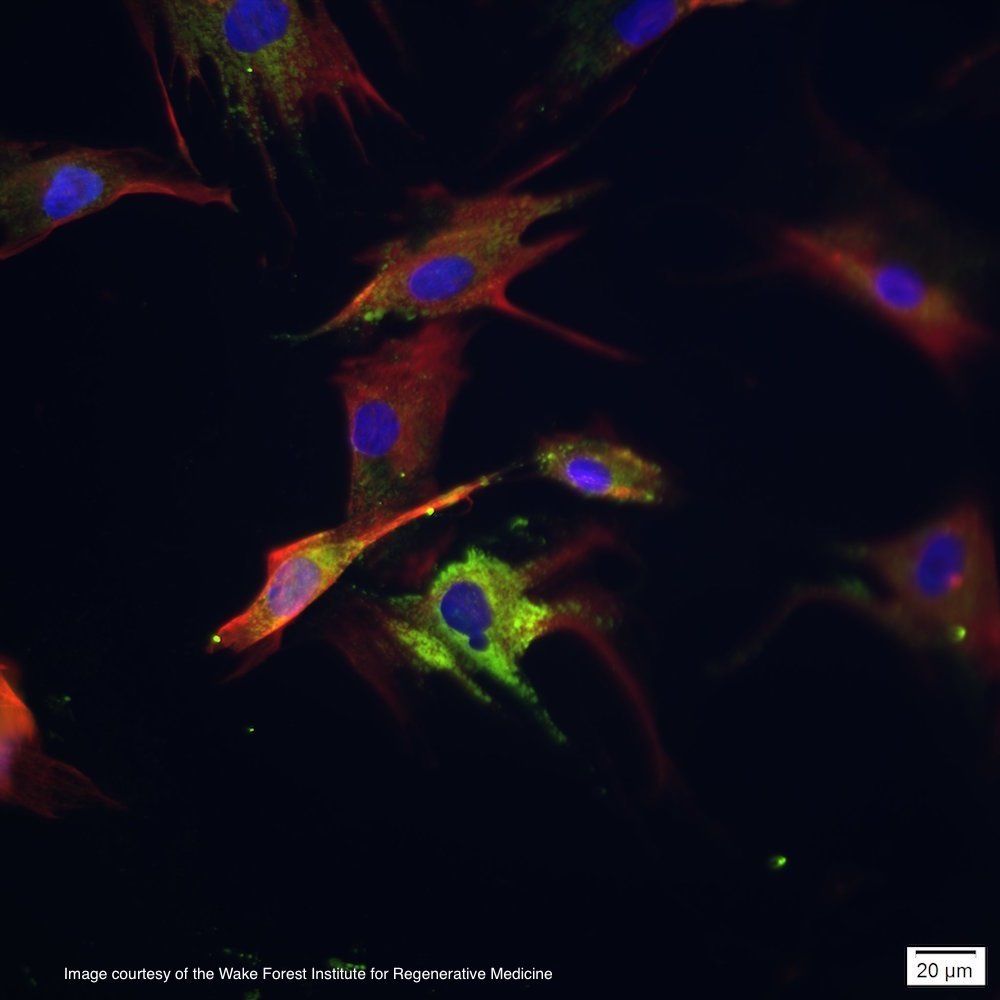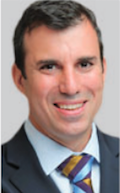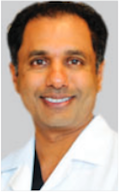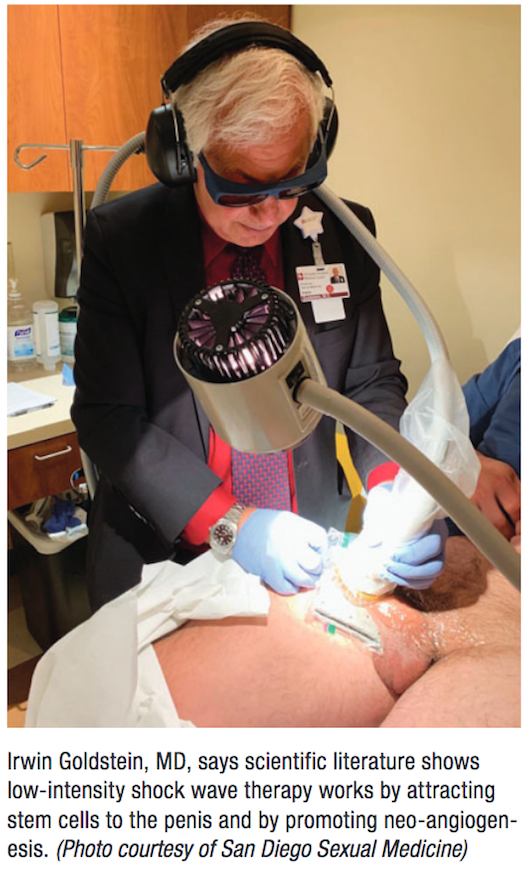Article
Stem cells pose risk, offer promise for ED, other diseases
Author(s):
Patients with urologic conditions have easy access to stem cell therapy options offered by a spectrum of providers at locations that vary from strip mall clinics to academic centers. But while there’s hope that cell-based therapies might not only treat symptoms but also modify diseases, including erectile dysfunction, the scientific evidence to show therapies using any stem cells work and don’t cause harm is lacking.
Image courtesy of the Wake Forest Institute for Regenerative Medicine

Patients with urologic conditions have easy access to stem cell therapy options offered by a spectrum of providers at locations that vary from strip mall clinics to academic centers. But while there’s hope that cell-based therapies might not only treat symptoms but also modify diseases, including erectile dysfunction, the scientific evidence to show therapies using any stem cells work and don’t cause harm is lacking.
The FDA warns that unapproved stem cell therapies can be harmful and may be illegal and unproven (bit.ly/FDAstemcell). The agency has tried to regulate stem cell clinics as part of a comprehensive move to oversee regenerative medicine products. In May, for example, the FDA announced it was seeking permanent injunctions to stop Cell Clinic of Sunrise, FL, and California Stem Cell Treatment Center, with locations throughout the state, to stop marketing stem cell products without FDA approval and for deviating from good manufacturing practice requirements.
Also see: How has FDA label change affected treatment of advanced bladder Ca?
Providers at the California clinic were injecting cancer patients’ tumors with stem cells from their fat.

“The product was then administered to cancer patients with potentially compromised immune systems and for whom the vaccine posed a potential for harm, including the possibility of inflammation and swelling of the heart and surrounding tissues,” the FDA said in a statement.
As recently as early September, the FDA sent a warning letter to Stemell, of San Juan Capistrano, CA, for “manufacturing and distributing unapproved products derived from umbilical cord blood and umbilical cord and for significant deviations from current good tissue practice (CGTP) and current good manufacturing practice (CGMP) requirements... creating potential significant safety concerns that put patients at risk.”
Urology in the fray
About 15% of the 169 stem cell clinics that were the subject of a recent report on the direct-to-consumer stem cell business in the southwest U.S. offered treatments for urologic conditions, including erectile dysfunction, interstitial cystitis, Peyronie’s disease, and bladder and kidney conditions (Stem Cell Reports 2019; 13:247-53).

“What we found was that clinics treating urologic conditions almost always treated a whole set of other conditions too that were not urologic in nature,” said the report’s first author, Emma K. Frow, PhD, assistant professor in the School for the Future of Innovation in Society and the School of Biological and Health Systems Engineering at Arizona State University, Tempe.
Only one, and possibly two, urologists were among the providers at the 169 clinics, according to the report.
The ThriveMD clinic in Denver and Vail, CO is one stem cell clinic offering urologic services. Scott Brandt, MD, the clinic’s medical director, trained as an anesthesiologist. Dr. Brandt treats joint and back pain, as well as erectile dysfunction. He uses adipose-derived stem cells for ED, according to the ThriveMD website.
“Besides adipose-derived cells, additional stem cells and growth factors are sourced from bone marrow concentrate,” according to the site. Dr. Brandt did not respond to Urology Times’ request for comment.
Next: The state of stem cell use in urology
The state of stem cell use in urology
Hundreds if not thousands of clinical trials are currently looking at stem cell use in medicine, according to Dr. Frow, but there are no FDA-approved stem cell products for conditions in urology and many other specialties.
Read: System tracks stent insertion, removal in EMR

Not only are stem cell procedures not yet approved in urology and other specialties, but there’s confusion among patients and providers about what stem cell therapies are, according to Anthony Atala, MD, professor of urology and regenerative medicine at Wake Forest School of Medicine, Winston-Salem, NC.
Platelet-rich plasma (PRP), for example, is a cell therapy-not a stem cell therapy.
“In reality, PRP is one of the very few treatments right now that can be used without FDA approval, and is being used,” Dr. Atala said.
Among the stem cell sources being studied are fat-derived stem cells and bone marrow-derived stem cells, which are autologous stem cells that providers harvest from patients and inject back into those patients in the same setting.
“The area in urology where those are being most used is in erectile dysfunction,” Dr. Atala said.
Researchers have found that a big challenge with using fat- and bone marrow-derived stem cells is that they don’t last when they’re reinjected.
“Basically, most of those cells are gone within a day after injection, and all the cells are gone within 5 days,” Dr. Atala said. “Longitudinal, well-controlled studies still need to be done to see what the long-term effects are from therapies using these cells that really don’t stay around.”
Researchers who tracked stem cells derived mostly from bone marrow, adipose tissue, or skeletal muscle and intracavernously injected them into the penis found the stem cells escaped the penis and went into bone marrow, and it wasn’t clear what happened after that (Stem Cells Dev 2012; 21:343–51).
Another drawback of using fat- and bone marrow-derived stem cells is that they are limited in their ability to differentiate into other cell types and their ability to be grown and expanded to large quantities, according to Dr. Atala.
Stem cells derived from muscle tissue do last. Researchers are studying muscle-derived stem cells for conditions like urinary incontinence, according to Dr. Atala.
But long-term research is limited on muscle-derived stem cells, he said.
Cord blood stem cells are yet another type of autologous stem cell. Cord blood cells, retrieved at birth, are stored for later use.
“Those are very similar in use to bone marrow-derived stem cells,” Dr. Atala said. “Like bone marrow cells, cord stem cells cannot be expanded very well and they cannot be converted to many other tissue types.”
The ideal stem cell should differentiate readily and expand to large quantities, which would make it easier to treat patients as many times as needed or at multiple sites. Although human embryonic stem cells and induced pluripotent stem cells have these properties, their major challenge lies in their potential to form tumors.
“Embryonic stem cells come from a discarded embryo. And induced pluripotent stem cells are from adult cells that can be reverted back to an embryonic-like cell by using specific genes or factors,” Dr. Atala said. Both cell types can be expanded rapidly and are usable in any tissue type, including liver, heart, and cartilage.
Because embryonic stem cells and induced pluripotent stem cells may form tumors, their translation to the clinical setting has been slow.
Amnion cells, which are from the placenta and amniotic fluid, are another stem cell type that differentiate, expand, and don’t form tumors.
“It’s a good cell type, but no cell is perfect,” Dr. Atala said. “One of the challenges with amnion cells is you have to work harder to drive them. With a human embryonic stem cell or an induced pluripotent stem cell, it only takes 7 days to convert those cells to liver cells. It takes 20 days to convert amnion stem cells to liver cells. However, that’s also the same property that does not allow the cells to form the tumors, because you get the cells a little bit later in terms of development.”
At the end of the day, scientists and physicians don’t know what any of these cells will do for patients long term, according to Dr. Atala.
“There are almost no longitudinal, prospective, randomized, controlled, double-blinded, long-term studies and therefore a lot of these therapies need to go through that process before they should be offered to patients outside the research setting,” Dr. Atala said.
A position statement by the Sexual Medicine Society of North America agrees that, until the FDA approves stem cell, PRP, or shock wave therapy for erectile dysfunction, use of these therapies is experimental and should be conducted under research protocols in compliance with Institutional Review Board approval (bit.ly/SMSNAposition).

Clinicians who retrieve adipose-derived stem cells and inject them into the penis to improve sexual function are providing unproven treatments and subjecting patients to potential risks, according to Peter Stahl, MD, director of male reproductive and sexual medicine at New York-Presbyterian Hospital/Columbia University Medical Center.
Also see: Large study offers more evidence of ADT-Alzheimer’s link
“It may be in the future that some of those therapies will emerge clinically effective, but at least to my knowledge at this point in time in late 2019 there is no evidence basis for injection of stem cells into the penis to promote erectile function,” Dr. Stahl said. “That being said, there has been a really widespread dissemination and utilization of stem cell-based techniques to promote and improve sexual function in men despite the lack of evidence. It’s a problem.”
Next:"The whole men’s health movement is ours to lose"

Urologist Koushik Shaw, MD, of Austin Urology Institute in Austin, TX, said patient demand and the concern that patients are going to non-urologic providers for unproven stem cell treatments is putting pressure on urologists like him to look into offering the therapies. While Dr. Shaw said he offers shock wave treatment for erectile dysfunction but no stem cell treatments, he is considering offering PRP if supported by clinical studies.
“I think it all has to be done with informed consent, with eyes wide open. Make sure the patient understands it’s not FDA approved, studies are limited, and the expectation should be limited,” Dr. Shaw said. “In our city, we have a plastic surgeon and ER physicians who offer shock wave therapy for erectile dysfunction. I see med spas doing it. The whole men’s health movement is ours to lose.”
Stem cell therapies are a different matter, according to Leigh Turner, PhD, associate professor at the Center for Bioethics, School of Public Health and College of Pharmacy at University of Minnesota, Minneapolis. Urologists and others who are concerned with being compliant and operating within evidence-based medical practice should consider steering clear of administering stem cell products, unless it’s in a research setting, according to Dr. Turner.
Read: Peyronie’s treatments costs, outcomes compared
“And it’s not clear whether down the road these are going to be evidence-based therapies,” said Dr. Turner. A 2016 paper that he co-authored found more than 50 of the 351 U.S. businesses engaged in direct-to-consumer marketing of stem cell interventions offered urologic services. Urologic conditions ranked seventh most common among 29 marketed conditions(Cell Stem Cell 2016; 19:154-7).

Dr. Turner called this risky terrain for urologists.
“They run the risk of violating federal law. If it’s a licensed medical practitioner, people could get in trouble with their state medical boards or the Federal Trade Commission,” Dr. Turner said.
For now, there are less risky and promising stem cell-like approaches to conditions such as erectile dysfunction. One is not to inject stem cells but rather attract stem cells to the penis with low-intensity shock wave therapy, according to Dr. Stahl.
“There’s a fairly large body of basic scientific literature indicating that low-intensity shock wave therapy works by attracting stem cells to the penis and by promoting neo-angiogenesis,” Dr. Stahl said.
Providing the therapy involves using an FDA-cleared device with “genuine” shock waves, according to Irwin Goldstein, MD, a urologist who practices sexual medicine in San Diego and and is director of the nonprofit Institute for Sexual Medicine (SexualMed.org).
“There are a lot of imitation non-shock wave acoustic sound waves that are being scammed and sold to patients who are desperate,” said Dr. Goldstein, who uses a device known as the UroGold 100. “Real shock wave therapy has been shown to activate endogenous stem cells. This specific device is FDA cleared now in the U.S. for increasing blood flow, connective tissue activation, and amelioration of pain, and the FDA has classified this device a non-significant risk (NSR) to humans.”
He said he has recruited patients for a prospective sham-controlled trial he will conduct looking at shock wave therapy with the UroGold 100 device for erectile dysfunction.
Pursuing evidence-based research on stem cell and other therapies for male sexual function is needed, according to Dr. Goldstein, who also offers PRP for erectile dysfunction.

“The construct of erectile dysfunction management by symptomatic treatment... is what we’ve mostly ever had,” he said. “But now with shock wave therapy, PRP, and one day maybe stem cells, the idea is having a disease modification strategy.
“It is the first time in erectile dysfunction history that we might change a primary underlying pathology and make the situation more responsive to symptomatic treatment or to where the person doesn’t even need symptomatic treatment.”
Dr. Turner filed an expert opinion report in a lawsuit filed against The Lung Institute, which markets purported stem cell treatments for lung diseases. Dr. Goldstein’s practice is a site for a trial sponsored by Tissue Genesis that uses stem cells for erectile dysfunction.
















